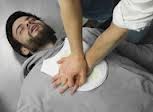Cardio-pulmonary resuscitation (=CPR) is known to save lives, but it has been known for some time that it has to be applied as early as possible to save lives on the longterm. In a recent study in Ottawa/Ont., which was published recently in the medical journal Circulation, the OPALS study checked out survival data.
OPALS is an acronym for Ontario Prehospital Advanced Life Support Study. One of the lead authors, Dr. Ian Stiell, emphasized that CPR done by bystanders (such as immediate family members) right in the beginning of a cardiac arrest will double the probability of having a survivor with quality of life that is very good.
Here are some detailed figures from that study. Only 14% to 15% of patients who suddenly collapse and are in need of CPR actually receive CPR. There were 8,091 cases of cardiac arrest that occurred between 1995 and 2000 in Ontario. Only 5.2% (418 patients) survived until the time of discharge from the hospital. 4% (324 patients) survived until the timeline of 1 year after the event. Of these the researchers were able to interview 268 survivors.
The following are a few observations from the OPALS study:
1. 85% of cardiac arrests happen at home.
2. 43% of cases are witnessed by bystanders, so if they all would know CPR about 3-times more unconscious patients could receive CPR (14% to 15% times 3 equals about 43%).
3. 65% of cardiac arrests in the OPALS study occurred in men. The authors recommended that women over 40 should get trained in CPR.
4. Women usually play a more pivotal role in taking care of elderly parents, of their spouse and of children, which puts them more likely into a situation where bystander CPR is required.
5. Family members of heart attack survivors should be encouraged to take a CPR course as the probability of a cardiac arrest is higher in these patients.
6. All 4 links to successful resuscitation are important: CPR by a bystander; defibrillation; rapid access to care; early advanced cardiac life support.
7. Contrary to rumors the long term outlook of successfully resuscitated patients is good and after 1 year the survivors have a quality of life as good as their healthy peers. However, without CPR initially the quality of life is only half as good as those who had someone provide CPR on them. The authors found it difficult to dispel some of the misconception surrounding CPR. Some of the myths are the notions that a person could do some harm by administering CPR or not performing CPR it correctly. They said it is important to be decisive and administer CPR to an unconscious person and call for an ambulance.
Summary: The OPALS study re-emphasized the importance for everybody to learn CPR. You never know when you need this skill. The more people know it, the more lives will be saved.
Here is a link to the University School of Medicine site entitled “Learn CPR – you can do it!”
Last edited December 8, 2012






